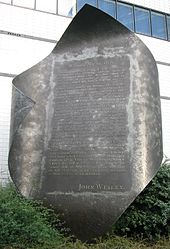
Back Quadrilateral metodista Catalan Quadrilateral wesleyano Spanish ウェスレーの四辺形 Japanese 웨슬리 사변형 Korean Czworobok Wesleyański Polish Quadrilátero Wesleyano Portuguese


The Wesleyan Quadrilateral,[1] or Methodist Quadrilateral,[2] is a methodology for theological reflection that is credited to John Wesley, leader of the Methodist movement in the late 18th century. The term itself was coined by 20th century American Methodist scholar Albert C. Outler.[3][4]
The Wesleyan Quadrilateral explicates the Methodist belief of prima scriptura.[5] This method bases its teaching on four sources as the basis of theological and doctrinal development. These four sources are chiefly scripture, along with tradition, reason, and Christian experience.
- ^ Wesleyan Quadrilateral, the – A Dictionary for United Methodists, Alan K. Waltz, Copyright 1991, Abingdon Press. Revised access date: 13 September 2016
- ^ The Methodist quadrilateral – Methodist Church in Britain. Access date: 17 July 2012.
- ^ Wesley, John (1964). Outler, Albert C. (ed.). John Wesley. Oxford, England, U.K.: Oxford University Press. p. iv. ISBN 0-19-502810-4.
- ^ Gunter, W. Stephen; Campbell, Ted A.; Jones, Scott J.; Miles, Rebekah L.; Maddox, Randy L. (1997). Wesley and the quadrilateral: renewing the conversation. Nashville, Tennessee: Abingdon Press. p. 17. ISBN 0-687-06055-9. OCLC 36884141.
- ^ Crawford, Nathan (1 June 2011). The Continuing Relevance of Wesleyan Theology: Essays in Honor of Laurence W. Wood. Wipf and Stock Publishers. p. 224. ISBN 978-1-60899-538-7.
© MMXXIII Rich X Search. We shall prevail. All rights reserved. Rich X Search